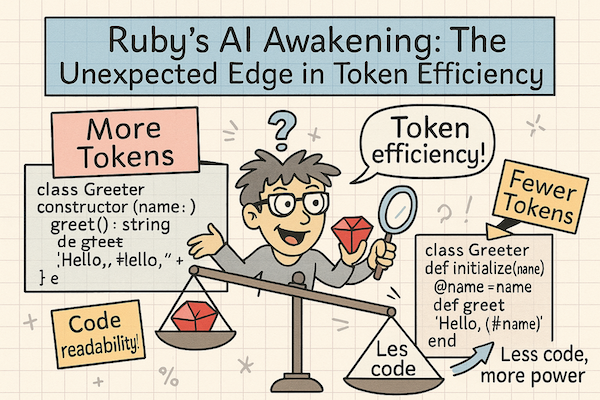
Ruby’s AI Awakening: The Unexpected Edge in Token Efficiency
Once hailed as the darling of developers and startups, Ruby and its popular framework Ruby on Rails faced a steady decline over the last decade. But just when Ruby seemed relegated to nostalgia for developers of the mid-2000s, a new player entered the scene that might launch Ruby back into relevance: Artificial Intelligence (AI).
The Fall: The Perceived Decline of Ruby
-
What happened? Despite its elegance, developer friendliness, and flexible syntax, Ruby has fallen out of favor over the years.
- Newer frameworks like Next.js, Django, and Node.js gained ground.
- HR and hiring trends shifted focus to trendier and more popular languages, feeding a vicious cycle where Ruby became less visible in job postings.
-
Major pain point: Technical recruitment often emphasizes specific language fluency (e.g., Python or JavaScript) over transferable skills like system design or domain expertise. This hurts versatile languages like Ruby.
Diagram: Why Ruby Fell Behind
Enter the Revolution: AI-Assisted Coding
In a coding landscape shaped by AI tools, a “vibe coding” revolution is underway. Tools like Cursor IDE, the Cline extension for VS Code, and GitHub Copilot allow developers to:
- Describe functionality in natural language (e.g., “I need a user service for managing users”).
- Generate complete implementations, refactor code, or troubleshoot in plain English.
Benefits:
- Faster coding: Developers can focus on architecture while AI engineers the mechanics.
- Token-based costs: AI pricing models are tied to the number of tokens (text chunks) processed.
- Seamless Integration: GitHub Copilot offers in-line code completions and context-aware suggestions directly in VS Code, reducing context switching and accelerating development.
The Comeback: Ruby’s Hidden Advantage
Ruby’s elegant design, focused on developer happiness and readability, turns into a cost-saving juggernaut in this AI era.
-
Readability = Efficiency: Ruby’s concise syntax means AI can capture complex ideas with fewer tokens compared to verbose languages like TypeScript or Java.
Example:
-
Cost Efficiency:
- Generating complex code costs approximately 1/3rd the tokens in Ruby compared to TypeScript.
- For businesses utilizing AI tools heavily, this translates to massive savings.
Showcasing Ruby’s Token Advantage
Here’s an actual comparison when writing a user service in TypeScript vs. Ruby:
TypeScript: (verbosely verbose)
interface User {
id: number;
firstName: string;
lastName: string;
email: string;
isActive: boolean;
}
class UserService {
private users: User[] = [];
public addUser(user: User): void {
this.users.push(user);
}
public getUserById(id: number): User | undefined {
return this.users.find((user) => user.id === id);
}
public getAllActiveUsers(): User[] {
return this.users.filter((user) => user.isActive);
}
}
Ruby: (clean and concise)
class User
attr_accessor :id, :first_name, :last_name, :email, :active
def initialize(id, first_name, last_name, email, active = true)
@id = id
@first_name = first_name
@last_name = last_name
@email = email
@active = active
end
end
class UserService
def initialize
@users = []
end
def add_user(user)
@users << user
end
def get_user_by_id(id)
@users.find { |user| user.id == id }
end
def get_all_active_users
@users.select(&:active)
end
end
The Economic Implications: Why Ruby Could Shine 🌟
As AI-assisted workflows spread, token efficiency becomes a critical factor. Here’s why Ruby stands to gain:
- Lower Costs: Teams using AI tools can save up to 3x on token processing costs by adopting Ruby over verbose languages like Java or TypeScript.
- Faster Turnaround: Ruby’s simplicity allows for quicker code generation, lower latency, and faster debugging workflows.
- Scalable AI Integration: Businesses can integrate AI coding tools effectively without breaking their budgets.
Diagram: AI Advantage with Ruby
Reflecting Forward: Will AI Resurrect Ruby?
Ruby won’t magically overthrow Python or JavaScript as the most in-demand languages tomorrow, but it might claim a unique niche in AI-assisted development. In a future where AI tools automate much of coding, programming languages will be evaluated based on cost-efficiency, readability, and their ability to adapt to AI workflows.
Story Takeaways:
- Focus less on trends and keywords; domain knowledge and transferable skills should be recruitment priorities.
- Ruby’s token efficiency makes it a perfect fit for AI-based coding workflows.
- Businesses relying on AI tools could see huge savings leveraging Ruby’s simplicity and expressiveness.
What do you think? Is this a second wind for Ruby? Could token efficiency become a major selection factor in tech stacks as AI tools dominate development?
Let’s keep reflecting, iterating, and coding… elegantly, the Ruby way!
Post Inspired by Yacine Petitprez’s article on the Ruby’s Renaissance in the AI Era.